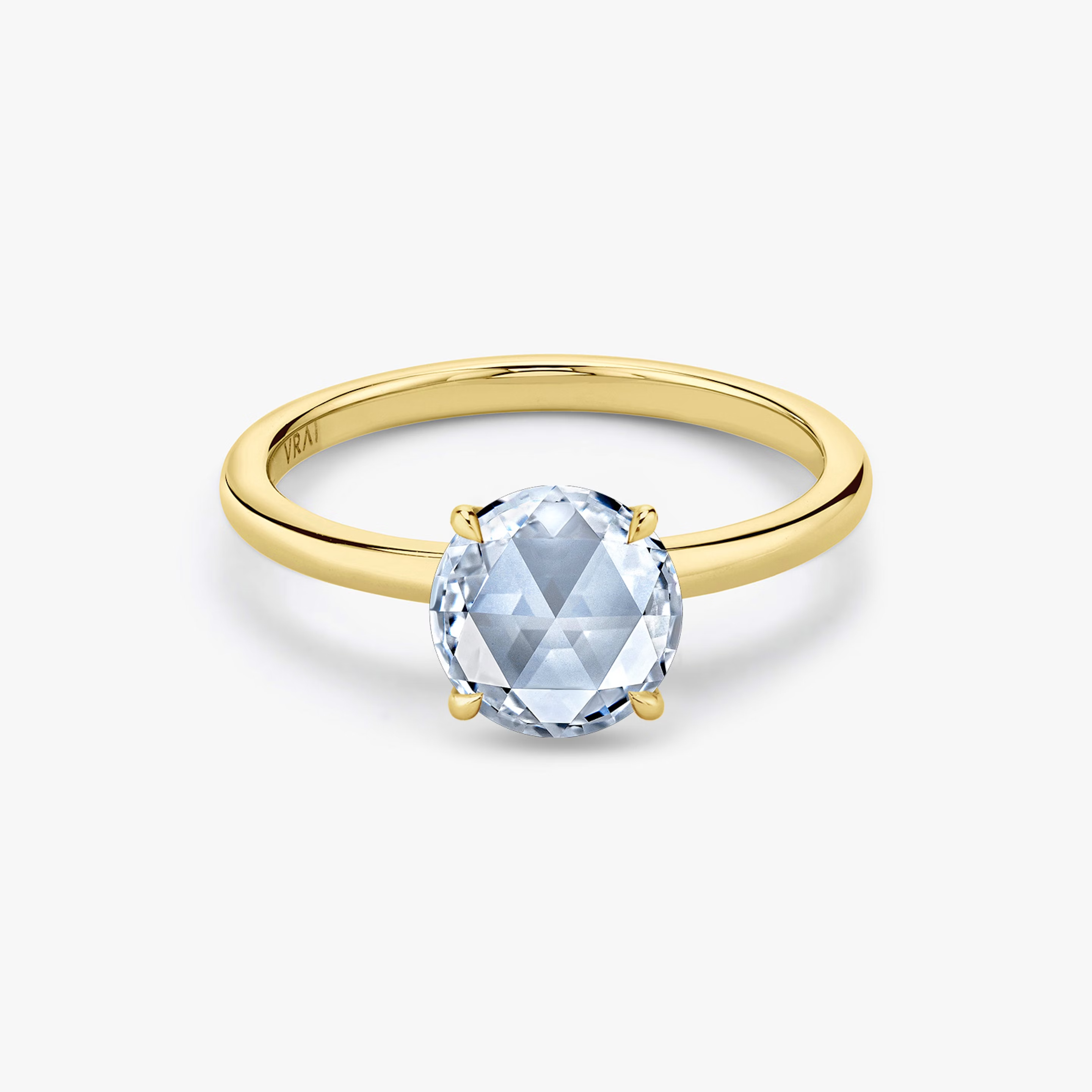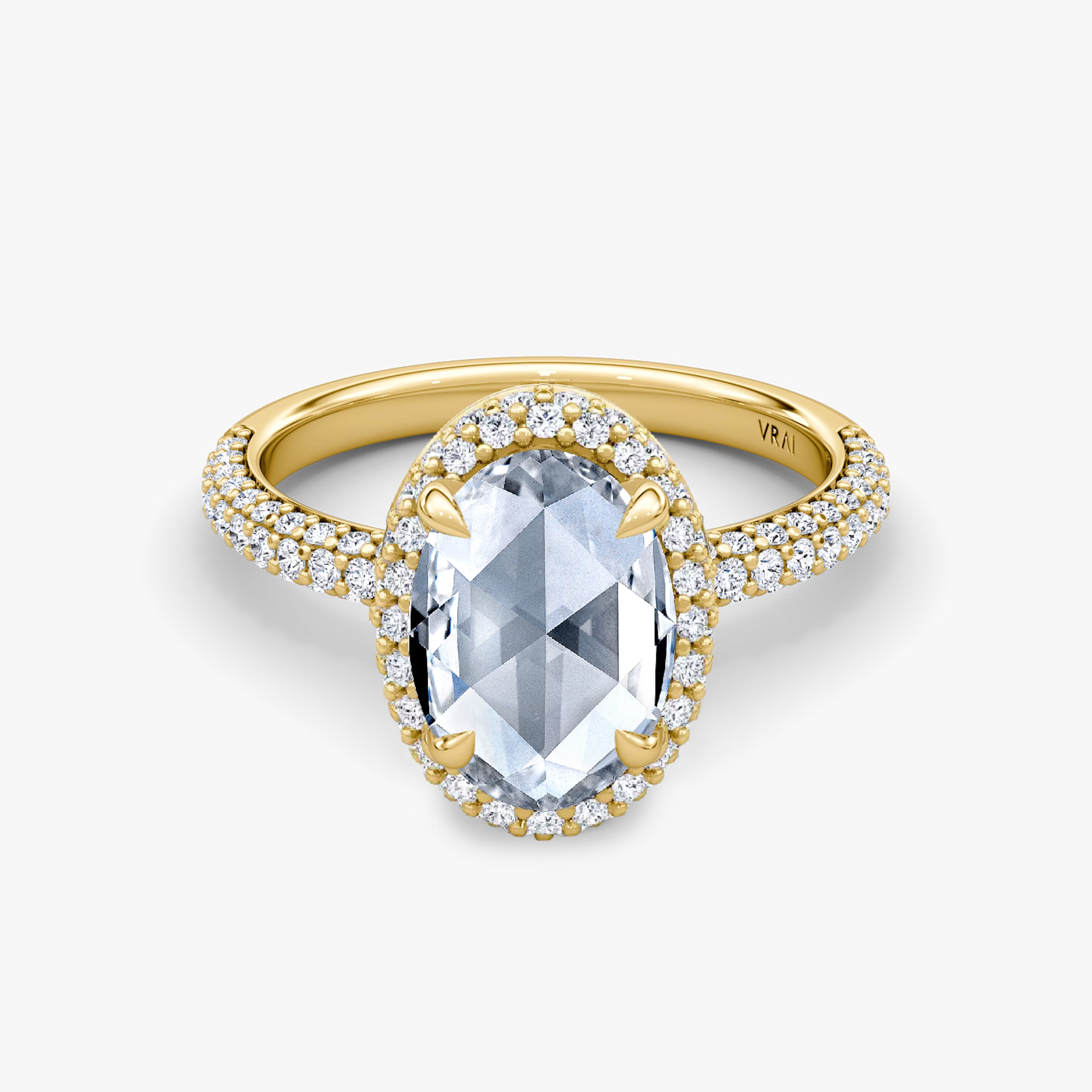Impeccable origin


Rose-Cut Diamonds: What Are They & How To Choose
Angelica Frey | April 12, 2023
A Rose Cut diamond owes its name to the fact that the facets on its top resemble the petals of a rose in their formation and pattern. Typically, a Rose-cut diamond has a flat bottom with no pavilion and a domed top, with a number of facets ranging from 3 to 24. VRAI created Rose Cut diamonds come both in round and oval shapes, and the lack of pavilion makes them have quite a large surface area, which is ideal both for those who prioritize finger coverage and for those who prefer a lustrous shimmer over the dazzling brilliance of Brilliant cuts. Our experts can show you how to pair them with engagement ring settings.
What is a Rose Cut Diamond?
A Rose cut diamond is one of the oldest diamond cuts recorded in history. “These are the oldest diamond cut, and really started off as simple irregular facets that created a domed shape that has no pavilion and performs extremely well in low lighting,” explains Queena Chang, VRAI’s Chief Diamond Expert and a GIA graduate gemologist. And while they rose to prominence in the Georgian Era of Jewelry —which is exactly the right timing for Versailles, and Louis XIV, Louis XV and Louis XVI—they remained prominent until the 19th century. “That’s when diversity of diamond cuts made the shape slip in popularity, as well as the advent of modern indoor lighting really showcasing the brilliance of newer shapes,” continues Chang. Still, in the last 15 years, they did experience a resurgence among independent jewelry designers focusing on vintage-inspired and dainty styles, and, regardless of current trends, they remain a favorite among customers who gravitate towards a romantic and vintage-inspired aesthetic.
What is the Difference Between a Rose Cut and a Brilliant Cut?
The easiest way to distinguish a Rose cut diamond from a Brilliant cut diamond is by envisioning the Rose cut as just the top of a Brilliant diamond. Truth is, the Rose cut diamond has a flat bottom with a domed shape, and a number of facets ranging from 3 to 24. By contrast, a Brilliant cut diamond has 57 to 58 facets distributed between the crown (top) and pavilion (bottom) that are either triangular or kite-shaped. Brilliant cuts are cut to maximize fire, brilliance, and scintillation, and because of that, they mask color and clarity characteristics. “Rose cut diamonds are cut with large flat facets to create scintillation and do not have much brilliance or fire,” says Chang. In addition, Rose cut is a cut, not a specific shape, so Rose cut diamonds can come in round, oval, and another multitude of other shapes.
Is a Rose Cut Diamond A Popular Cut for Engagement Rings?
Rose Cut diamonds have experienced a surge in popularity thanks to recent trends in jewelry design when it comes to engagement rings and recent examples of engagement rings among celebrities. In addition, those who prize large surface areas will naturally gravitate towards this shape because the weight distribution of Rose cut diamonds and their lack of pavilion will result in a larger surface area per carat weight. Still the most popular choice regarding engagement rings is the Brilliant cut, with the Round Brilliant cut being by far the most ubiquitous shape. In fact, they make up between two thirds and 75% of all diamonds sold, and about 60% of all engagement rings.
Can a Rose Cut Diamond be a Lab-Grown Diamond?
Rose cut diamonds can absolutely come from lab-grown diamonds: any raw diamond, regardless of origin, can be cut, cleaned, and polished into shapes both antique and contemporary. In fact, lab-grown and mined diamonds share the same physical, chemical, and optical properties, and undergo the same growth process. Extreme heat and pressure turns carbon into a rough diamond, that is then cut and polished by master cutters. Both lab-grown diamonds and mined diamonds are graded on the same scale, but lab-grown diamonds are free of human and environmental impact. All Rose Cut VRAI created diamonds are made with true zero emissions.
Best Rose Cut Engagement Ring Styles
Rose cuts suit a wide variety of engagement rings, but, given the legacy of this cut, it can inherently feel vintage-inspired. It doesn’t have to be this way, though. “I would avoid pairing the center rose cut with too many rose cut accents, especially as a halo or five stone as these are very common in vintage designs but not in modern pairings,” said Chang. “I would also avoid too unique of a setting (three stones set north south, etc) as this would also date the design.” And if the lack of fire bothers you, Chang suggests some tricks. “I would recommend setting a Rose cut in a Three stone with tapered baguettes or in a solitaire with pavé accents on the band to add some subtle shine to the ring without overtaking the center diamond,” she said.
Be the first to know
Hear about our latest designs and upcoming events.

Round Rose Cut Engagement Rings
The Round Rose Cut is a timeless and classic shape. The Signature solitaire ring is a natural fit for a Round Rose cut, as the shape naturally accommodates the Signature’s low setting.

Oval Rose Cut Engagement Rings
An Oval Rose cut has a very large surface area that won’t feel too overwhelming in its brilliance thanks to the Rose cut’s subtle shimmer. The Halo Dome looks both timeless and maximalist when featuring an Oval Rose diamond as its center stone.

Multi Stone Rose Cut Engagement Rings
If you choose a Rose-cut diamond as your center stone, you’ll see how naturally it harmonizes with other side stones, whether they’re brilliant or step-cut diamonds. The Five Stone Heirloom with an Oval Rose results into an interesting combination of step-cut facets and the geometric, large Rose cut diamond facets.
Shop Rose Cut VRAI Created Diamonds With Our Experts
A Rose cut is both vintage-inspired and thoroughly modern. Rose cut diamonds are specifically cut and polished to suit you, as part of our Cut for You process. A VRAI diamond expert will be able to educate you on this diamond shape and point you towards the best ring setting.